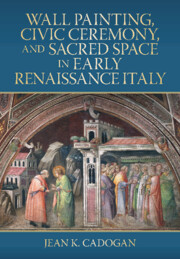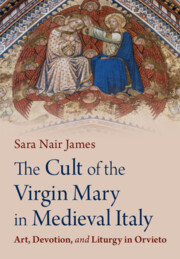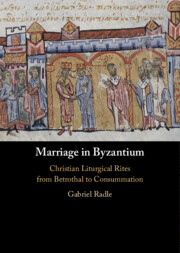Refine search
Actions for selected content:
155 results
Chapter 7 - The Sacramental Structure and Imagination of Augustine’s Confessions
-
-
- Book:
- Augustine's ‘Confessions'
- Published online:
- 16 December 2025
- Print publication:
- 22 January 2026, pp 127-144
-
- Chapter
- Export citation
Chapter 8 - A Theological Hermeneutics of Jewish Liturgy
- from Part III - A Program for a Positive Jewish Theology
-
- Book:
- Reviving Jewish Theology
- Published online:
- 20 November 2025
- Print publication:
- 04 December 2025, pp 193-224
-
- Chapter
- Export citation

The Cambridge Companion to Christian Liturgy
-
- Published online:
- 19 September 2025
- Print publication:
- 09 October 2025

Wall Painting, Civic Ceremony, and Sacred Space in Early Renaissance Italy
-
- Published online:
- 19 September 2025
- Print publication:
- 23 October 2025
Chapter 6 - Living in Sacred Time (Leviticus 23)
-
- Book:
- The Theology of the Book of Leviticus
- Published online:
- 18 July 2025
- Print publication:
- 07 August 2025, pp 203-233
-
- Chapter
- Export citation

The Cult of the Virgin Mary in Medieval Italy
- Art, Devotion, and Liturgy in Orvieto
-
- Published online:
- 24 July 2025
- Print publication:
- 24 July 2025
7 - Sermons for Lent, Good Friday, and Easter
- from Part II - Augustine’s Sermons on the Scriptures and Liturgical Feasts
-
-
- Book:
- The Cambridge Companion to Augustine's Sermons
- Published online:
- 26 May 2025
- Print publication:
- 12 June 2025, pp 133-151
-
- Chapter
- Export citation
3 - Transmission and Collections of Augustine’s Sermons
- from Part I - Augustine’s Pastoral Task of Preaching Sermons
-
-
- Book:
- The Cambridge Companion to Augustine's Sermons
- Published online:
- 26 May 2025
- Print publication:
- 12 June 2025, pp 60-78
-
- Chapter
- Export citation

Marriage in Byzantium
- Christian Liturgical Rites from Betrothal to Consummation
-
- Published online:
- 01 May 2025
- Print publication:
- 23 January 2025
4 - Papal Ceremonial: From Christian Liturgy to Social Media
- from Part I - Spaces, Liturgies, Travels
-
-
- Book:
- The Cambridge History of the Papacy
- Published online:
- 28 February 2025
- Print publication:
- 20 March 2025, pp 124-150
-
- Chapter
- Export citation
Chapter 3 - Subjection
-
- Book:
- Protestant Bodies
- Published online:
- 20 February 2025
- Print publication:
- 27 February 2025, pp 118-161
-
- Chapter
- Export citation
13 - Liturgical Philosophy of Religion
- from Part IV - Forms and Functions of Worship
-
-
- Book:
- The Philosophy of Worship
- Published online:
- 09 January 2025
- Print publication:
- 23 January 2025, pp 229-254
-
- Chapter
- Export citation
Introduction
-
- Book:
- Marriage in Byzantium
- Published online:
- 01 May 2025
- Print publication:
- 23 January 2025, pp 1-10
-
- Chapter
- Export citation
5 - The Euchologion: Sources and Methods
- from Part III - Marriage Rites in Byzantine Liturgical Manuscripts
-
- Book:
- Marriage in Byzantium
- Published online:
- 01 May 2025
- Print publication:
- 23 January 2025, pp 183-210
-
- Chapter
- Export citation
Conclusion: Byzantine Marriage beyond Byzantium
- from Part III - Marriage Rites in Byzantine Liturgical Manuscripts
-
- Book:
- Marriage in Byzantium
- Published online:
- 01 May 2025
- Print publication:
- 23 January 2025, pp 352-355
-
- Chapter
- Export citation
6 - Rites of Betrothal
- from Part III - Marriage Rites in Byzantine Liturgical Manuscripts
-
- Book:
- Marriage in Byzantium
- Published online:
- 01 May 2025
- Print publication:
- 23 January 2025, pp 211-240
-
- Chapter
- Export citation
The origins of liturgical lawlessness
-
- Journal:
- Ecclesiastical Law Journal / Volume 27 / Issue 1 / January 2025
- Published online by Cambridge University Press:
- 07 March 2025, pp. 60-67
- Print publication:
- January 2025
-
- Article
- Export citation
The future of liturgy and law
-
- Journal:
- Ecclesiastical Law Journal / Volume 27 / Issue 1 / January 2025
- Published online by Cambridge University Press:
- 07 March 2025, pp. 72-82
- Print publication:
- January 2025
-
- Article
- Export citation
The law of liturgy: a theological context
-
- Journal:
- Ecclesiastical Law Journal / Volume 27 / Issue 1 / January 2025
- Published online by Cambridge University Press:
- 07 March 2025, pp. 54-59
- Print publication:
- January 2025
-
- Article
- Export citation
9 - Sacred Genres
- from Part III - Fundaments of the Art
-
- Book:
- The Art of Counterpoint from Du Fay to Josquin
- Published online:
- 05 December 2024
- Print publication:
- 12 December 2024, pp 167-188
-
- Chapter
- Export citation
